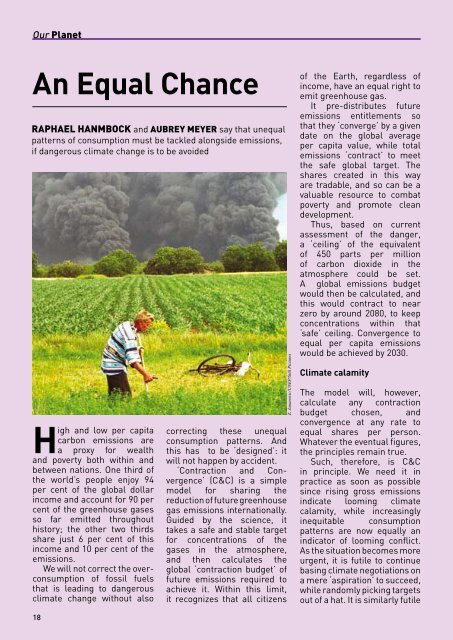UNEP Magazine "Climate change and economic development"
UNEP Magazine "Climate change and economic development"
UNEP Magazine "Climate change and economic development"
You also want an ePaper? Increase the reach of your titles
YUMPU automatically turns print PDFs into web optimized ePapers that Google loves.
Our Planet<br />
An Equal Chance<br />
Raphael Hanmbock <strong>and</strong> Aubrey Meyer say that unequal<br />
patterns of consumption must be tackled alongside emissions,<br />
if dangerous climate <strong>change</strong> is to be avoided<br />
High <strong>and</strong> low per capita<br />
carbon emissions are<br />
a proxy for wealth<br />
<strong>and</strong> poverty both within <strong>and</strong><br />
between nations. One third of<br />
the world’s people enjoy 94<br />
per cent of the global dollar<br />
income <strong>and</strong> account for 90 per<br />
cent of the greenhouse gases<br />
so far emitted throughout<br />
history; the other two thirds<br />
share just 6 per cent of this<br />
income <strong>and</strong> 10 per cent of the<br />
emissions.<br />
We will not correct the overconsumption<br />
of fossil fuels<br />
that is leading to dangerous<br />
climate <strong>change</strong> without also<br />
correcting these unequal<br />
consumption patterns. And<br />
this has to be ‘designed’: it<br />
will not happen by accident.<br />
‘Contraction <strong>and</strong> Convergence’<br />
(C&C) is a simple<br />
model for sharing the<br />
reduction of future greenhouse<br />
gas emissions internationally.<br />
Guided by the science, it<br />
takes a safe <strong>and</strong> stable target<br />
for concentrations of the<br />
gases in the atmosphere,<br />
<strong>and</strong> then calculates the<br />
global ‘contraction budget’ of<br />
future emissions required to<br />
achieve it. Within this limit,<br />
it recognizes that all citizens<br />
Z. Jananovic/<strong>UNEP</strong>/Still Pictures<br />
of the Earth, regardless of<br />
income, have an equal right to<br />
emit greenhouse gas.<br />
It pre-distributes future<br />
emissions entitlements so<br />
that they ‘converge’ by a given<br />
date on the global average<br />
per capita value, while total<br />
emissions ‘contract’ to meet<br />
the safe global target. The<br />
shares created in this way<br />
are tradable, <strong>and</strong> so can be a<br />
valuable resource to combat<br />
poverty <strong>and</strong> promote clean<br />
development.<br />
Thus, based on current<br />
assessment of the danger,<br />
a ‘ceiling’ of the equivalent<br />
of 450 parts per million<br />
of carbon dioxide in the<br />
atmosphere could be set.<br />
A global emissions budget<br />
would then be calculated, <strong>and</strong><br />
this would contract to near<br />
zero by around 2080, to keep<br />
concentrations within that<br />
‘safe’ ceiling. Convergence to<br />
equal per capita emissions<br />
would be achieved by 2030.<br />
<strong>Climate</strong> calamity<br />
The model will, however,<br />
calculate any contraction<br />
budget chosen, <strong>and</strong><br />
convergence at any rate to<br />
equal shares per person.<br />
Whatever the eventual figures,<br />
the principles remain true.<br />
Such, therefore, is C&C<br />
in principle. We need it in<br />
practice as soon as possible<br />
since rising gross emissions<br />
indicate looming climate<br />
calamity, while increasingly<br />
inequitable consumption<br />
patterns are now equally an<br />
indicator of looming conflict.<br />
As the situation becomes more<br />
urgent, it is futile to continue<br />
basing climate negotiations on<br />
a mere ‘aspiration’ to succeed,<br />
while r<strong>and</strong>omly picking targets<br />
out of a hat. It is similarly futile<br />
18

















